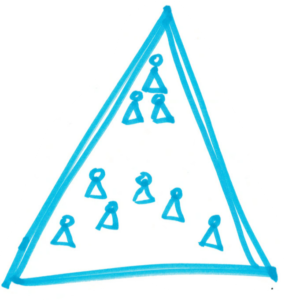One of the most important lessons I have learned over the last few years is that Organizational Behaviour Follows Leadership Behaviour. Lasting improvements can only start with leaders modeling new behaviours. I use this all the time to help leaders choose what they really want for themselves and their organizations.
Current Organization Behaviour is a result of Current Leadership Behaviour
 Think of your organization. It has certain characteristic or properties that determines how well it functions.
Think of your organization. It has certain characteristic or properties that determines how well it functions.
Q: Who is responsible and can take credit for how the organization is functioning?
A: The leaders of the organization. They are responsible for the organization and how it is changing over time.
On the left we see an illustration of structured, low-flexibility organization resulting from one kind of leadership and culture.
When we examine culture and leadership closely, we see that they are two sides of the same coin; neither can really be understood by itself. On the one hand, cultural norms define how a given nation or organizations will define leadership—who will get promoted, who will get the attention of followers. On the other hand, it can be argued that the only thing of real importance that leaders do is to create and manage culture.
– Prof. Edgar Schein, MIT Sloan School of Management
New Organizational Behaviour Requires New Leadership Behaviour
 Imagine we want a new kind of behaviour in our organization. For example, we want to be more agile – able to be nimble in the market and innovate our products and services to delight our customers and make waves for our competition. The image on the left illustrates this.
Imagine we want a new kind of behaviour in our organization. For example, we want to be more agile – able to be nimble in the market and innovate our products and services to delight our customers and make waves for our competition. The image on the left illustrates this.
Q: What kind of leadership will be required in this new way of working?
A: Different from what we have now!
If we want to have a new way of working, many things will change. In particular, leadership which fosters culture will need to be very different.

Growth Starts with Leaders
Since Organizational Behaviour follows Leadership Behaviour, we can see that leadership is the limit for growth in organizations.
There are only a small number of options around developing an agile organization:
- Support leaders on a transformational journey to become the future leaders.
- Exit the leadership of the organization and replace them with leaders with the desired mindset/culture. This is exactly what was done with the NUMMI joint venture by GM and Toyota.
- Abandon the goal of developing an agile organization.
I don’t see #2 very often in my practice. It does happen, though. Here is a recent article about a CEO who fired his management team in order to shift the culture.
In my own work helping leaders, I always offer a choice between #1 and #3. After all it’s their organization. I used to really want leaders to pick #1, but now I am less attached and focus on creating safety and control for leaders. And now I have had more leaders pick #1. And helping leaders on this journey is what I am about.
Acknowledgements
I would like to thank Glenda Eoyang who shared a very important teaching with me when I was in one of her trainings: “The organization is a fractal of the leadership team. Whatever you see in the leadership team, you will see in the organization.”. It also applies to each leader: “Whatever is in the head of a leader, you will see manifested in the leadership team.”
Olaf Lewitz created the wonderful question: “Who is responsible for the current organization?”


